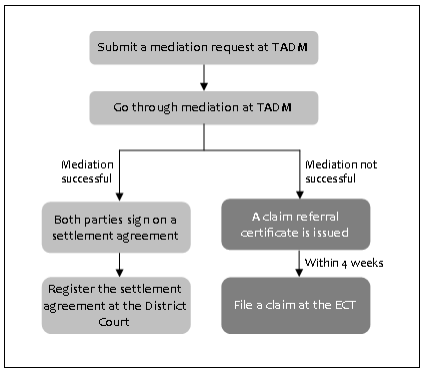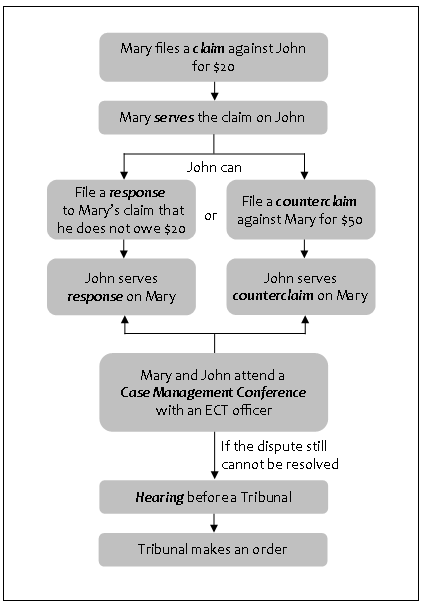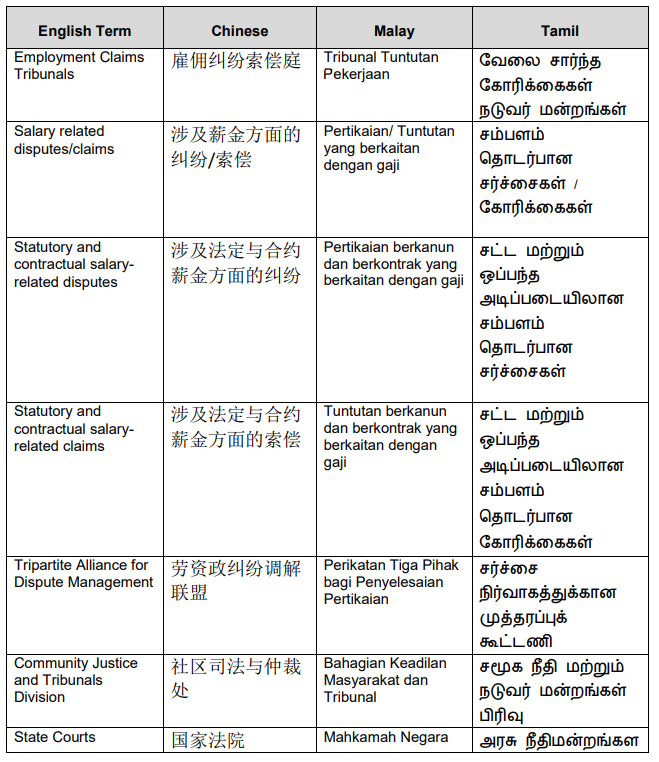Media Release: State Courts launch new Employment Claims Tribunals
1. The State Courts will launch the new Employment Claims Tribunals (ECT) on 1 April 2017 to facilitate the expeditious resolution of employment disputes.
2. Established under the Employment Claims Act, the ECT will hear all statutory salary-related claims from employees covered under the Employment Act, Retirement and Re-employment Act, and Child Development Co-Savings Act. The types of statutory salary-related claims include unpaid salary, overtime pay, salary in lieu of notice, employment assistance payments, and maternity benefits. In this respect, it will take over the function of what is commonly known as Labour Court at the Ministry of Manpower.
3. In addition, the new ECT will hear more types of claims as compared to the Labour Court as it will hear contractual salary-related claims from employees, including Professionals, Managers and Executives (PMEs) who earn more than S$4,500 per month. Such claims include payment of allowances, bonuses, commissions, salary in lieu of notice and retrenchment benefits, provided that these are expressed in monetary terms in the contract. This will bridge a current gap for this group of persons who are not covered under the Employment Act, and whose only recourse prior to the establishment of the ECT would be through the Civil Courts.
4. Similar to the Small Claims Tribunals, the ECT is designed to provide a speedy, low-cost forum for parties to resolve their employment disputes. The ECT will have simplified procedures and will be judge-led. In addition, no lawyers will be involved. Because of the simplified procedures, the ECT will not be a forum for complicated employment claims and as such, the tribunals will only have jurisdiction to hear claims up to S$20,000 or up to S$30,000 if the dispute has undergone mediation assisted by the unions.
5. Mediation will play a critical role in the employment dispute resolution process to encourage the parties to resolve the matter amicably. The ECT will only hear cases that have 2 // 2 undergone mediation at the Tripartite Alliance for Dispute Management (TADM). If the mediation is unsuccessful, parties will be given a claim referral certificate to file a claim at the ECT.
6. The ECT has been established to provide an effective and affordable dispute resolution forum to assist more employees to resolve their employment-related disputes with their employers. The processes have been designed to ensure that all those in need are able to navigate and access adjudicatory processes. Presiding Judge of the State Courts, Justice See Kee Oon said, “The State Courts continuously seek to be responsive to the evolving needs of society, and we recognise that certain matters can benefit from a judge-led and less adversarial approach in a tribunal setting. The launch of the ECT is another example of the State Courts’ ongoing efforts to provide better access to justice and serve society.”
Issued by: State Courts, Singapore
Date: 31 March 2017
Enclosed:
(i) Annex A – Factsheet: Types of claims and claimants overview
(ii) Annex B – Factsheet: Filing a claim at the ECT
(iii) Annex C – Factsheet: Main stages of an ECT claim
(iv) Annex D – Factsheet: Filing a settlement agreement
(v) Annex E – Translation of key terms
For further information or clarification, please contact:
(i) Ms Marilyn Tan, Assistant Director, Communications Directorate
Tel: 6435 5652 / 9722 6139
Email: marilyn_tan@statecourts.gov.sg
(ii) Ms Cheryl Ho, Senior Executive, Communications Directorate
Tel: 6435 5498 / 9722 6139
Email: cheryl_ho@statecourts.gov.sg
Annex A
Employment Claims Tribunals
Annex A Employment Claims Tribunals
| Statutory salary-related claims | Contractual salary-related claims | |
| All employees under the following Acts: | ||
| Employment Act | Y | Y |
| Retirement and Re-employment Act | Y | Y |
| Child Development Co-Savings Act | Y | Y |
| Other specific groups: | ||
| PMEs earning > $4,500.00 /month | NA | Y |
* No change to the following for contractual salary-related claims:
- Public servants have recourse through the Public Service’s internal processes
- Domestic workers can approach their employment agencies and MOM to resolve employment disputes
- For seafarers, they can settle disputes, including salary-related disputes, under the Merchant Shipping (Maritime Labour Convention) Act.
* Statutory salary-related claims are those relating to employee entitlements under the Employment Act, Retirement & Re-employment Act and the Child Development Co-Savings Act. These include unpaid salary, overtime pay, salary in lieu of notice of termination, employment assistance payments, and maternity benefits.
* Contractual salary-related claims from employees include, among other things, payment of allowances, bonuses, commissions, salary in lieu of notice and retrenchment benefits, provided that these are expressed in monetary terms in the contract.
Annex B
Employment Claims Tribunals
Annex B Employment Claims Tribunals
Before you file a claim at the ECT, you must first submit a mediation request at the Tripartite Alliance for Dispute Management (TADM).

If your dispute is not resolved at TADM mediation, you will be issued a claim referral certificate. Thereafter, you may file a claim at ECT.
How to file a claim at the ECT
Step 1
Fill up a claim form, which can be downloaded from the State Courts website. The details in the claim form must be typewritten.
Step 2
Submit your claim form, claim referral certificate, and supporting documents to the Employment Claims Registry located in the Community Justice and Tribunals Division, at Level 1 of the State Courts building.
Step 3
Pay the filing fee. The fees are as follows:
- S$30 for a claim amount of S$10,000 or less
- S$60 for a claim amount of more than S$10,000
The Employment Claims Registry will issue you a notice of case management conference (CMC) which states the date and time to attend the CMC.
Annex C
Employment Claims Tribunals
Factsheet: Main stages of an ECT claim
The diagram below is an example of some of the main stages the claimant and respondent can expect to go through.

Annex D
Employment Claims Tribunals
Annex D Employment Claims Tribunals
Any party to a settlement agreement may apply to register it. The application must be made within 4 weeks after all parties have signed the settlement agreement.
How to apply to register the settlement agreement
Step 1
Download the form for “Application for registration of settlement agreement” from the State Courts website.
Step 2
File the completed application at the Employment Claims Registry. The Employment Claims Registry is located in the Community Justice and Tribunals Division, at Level 1 of the State Courts building.
Step 3
Bring the following documents together with your application:
- Identification documents
- For individuals: NRIC, Passport or Employment Pass
- For company representatives: Latest ACRA profile, letter of authorisation, and NRIC, Passport or Employment Pass of representative - Three (3) copies of the signed settlement agreement
- Registration fee of S$10
If the registration is successful, a notice of registration and a copy of the registered settlement agreement will be sent to you. You must then serve these documents immediately on the other party.
The registration of the settlement agreement is valid for 3 years from the date of its registration.
Annex E
Translation of key terms:









